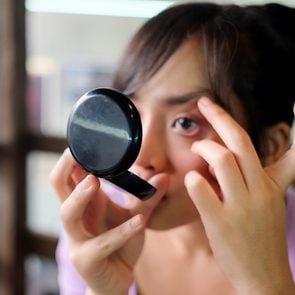She Was Losing Her Vision, and Her Son Had Life-Threatening Dehydration—Could the Cases Be Linked?

When a mother and son began to experience health issues at the same time, doctors struggled for answers. Was a rare genetic condition to blame?
Kimberly Macurdy has always had trouble seeing things. She started wearing glasses as a young child, and her prescription became progressively stronger as she grew up. Over the last few decades, the 57-year-old mother of three performed so poorly on eye exams that optometrists, in disbelief, would ask her to cut it out and start paying attention.
In 2008, a sudden worsening of her eyesight caused Macurdy to suspect it was more than run-of-the-mill vision loss. One day, sitting in the kitchen of her home just north of Houston, Texas, Macurdy couldn’t read the time on her microwave from across the room, even with her glasses on. At her job as a purchasing manager for a manufacturing company, she gradually had trouble focusing on spreadsheets that were right in front of her.
Macurdy’s optometrist couldn’t figure out what was causing her symptoms, nor could a series of experts—including an ophthalmologist, a retina specialist and an optics specialist—who examined her over the following year. A few doctors decided the likeliest explanation was that she was stressed and imagining her symptoms, given her familial situation: around the same time, the youngest of her three children, seven-year-old Braden, went to the emergency room three times for vomiting, fever and life-threatening dehydration. She was stressed, but she insisted she wasn’t making things up and kept pursuing fresh opinions.
In 2009, Macurdy saw Dr. Andrew Lee, the head of ophthalmology at Houston Methodist Hospital’s Blanton Eye Institute. One evening shortly before her appointment, as she was making her way to bed, she had a seizure, dropping to the ground and shaking uncontrollably. She somehow got up into her bed, where she later awoke in a puddle of her own urine.
Macurdy had suffered seizures before, but this one inspired her to write down a list of her other persistent health challenges: rheumatoid arthritis, an off-kilter gait, recurring fevers, and the vision problems, which had since gotten worse. She had started seeing things in double and experiencing eye tremors. “It felt like my eyes were bouncing around like a basketball,” she says.
Macurdy faxed her list to Lee, hoping that he could connect the dots. When she arrived at his office, she was impressed with his quick grasp of her situation. He wasn’t certain what was afflicting Macurdy, but he had a hunch: multiple sclerosis. MS causes the immune system to attack myelin, fatty tissue that coats and protects nerves, which often results in vision problems. People with MS are also more likely to experience difficulty walking. After the appointment, Macurdy sat in her car and cried—not over the chance that she had MS, but about the possibility of knowing what was wrong with her. “Finally,” she says, “someone agreed I was actually experiencing this.”
An MRI later confirmed Lee’s hypothesis: the myelination in Macurdy’s brain was abnormal, indicating that she likely had MS, although there is no definitive way to test for the disease. MS also has no cure, but Macurdy’s doctors prescribed her a raft of medications to treat symptoms and sent her home.
Around the time Macurdy began to get some answers, so did her son. An endocrinologist surmised that Braden’s health scares had been caused by a dysfunction of his adrenal glands, which produce the natural steroids a body needs to excrete excess potassium. The doctor prescribed him hydrocortisone to balance out the chemicals in his body.
Over the next five years, Macurdy and her son scraped by. Between the two of them, they had at least one medical appointment a week. Macurdy’s initial MS medications didn’t work as well as expected, so her doctors kept prescribing her new ones. At one point, she was taking 22 pills a day. She was over- whelmed trying to juggle both her own health and Braden’s. “Life was just ultra-weird,” she says. “I continued to fall off the ledge.”
In 2015, Braden landed in hospital again after another bout of vomiting. Macurdy pushed doctors to perform a number of additional tests to figure out why her son was sick—and in 2016, the results of a genetic test revealed Braden had a mutation in a gene that normally helps cells break down very long chain fatty acids. These acids insulate nerve fibres in the brain, but an excess of them was damaging the myelin throughout his body. The condition is known as adrenoleukodystrophy (ALD). It affects roughly one in 20,000 people, and there is no cure. Some carriers are asymptomatic and live full lives, while others die in adolescence. When Braden, then 15, asked doctors how long he’d live, they answered, “We don’t know.”

It was a devastating diagnosis, but it came with a silver lining. The next time Macurdy saw Lee, she casually mentioned Braden’s diagnosis. “He literally stopped his pen mid-stroke and said, ‘Wait a minute,’” says Macurdy. Lee wondered whether ALD, a genetic disease, could explain Macurdy’s illness. Indeed, in addition to having MS, a genetic test revealed that she had the same gene mutation as her son. The two mysteries had always been one.
ALD is linked to the X chromosome, which causes it to manifest primarily in men. “That’s why the son was showing all the symptoms and the diagnosis was so obvious in him,” says Lee. It’s far rarer for women to show signs of ALD because they have two X chromosomes—one can serve as a backup if the other is affected by a mutation. Female carriers of ALD, therefore, typically display milder symptoms, or none at all.
After her diagnosis, Macurdy scoured ALD support groups on Facebook and found a specialist at the Mayo Clinic in Rochester, Minnesota. That doctor now sees Macurdy and Braden at least once a year, performing tests and blood work to monitor warning signs and ensure the disease doesn’t progress.
After a lifetime of battling perplexing symptoms, Macurdy is relieved to know what she—and her son—are up against. “If I had not forced doctors to look, we really wouldn’t know,” she says. “But I’m no hero. A mom does what a mom has to do.”
Next, check out a medical mystery that will make you think twice about how you dress your bed.








